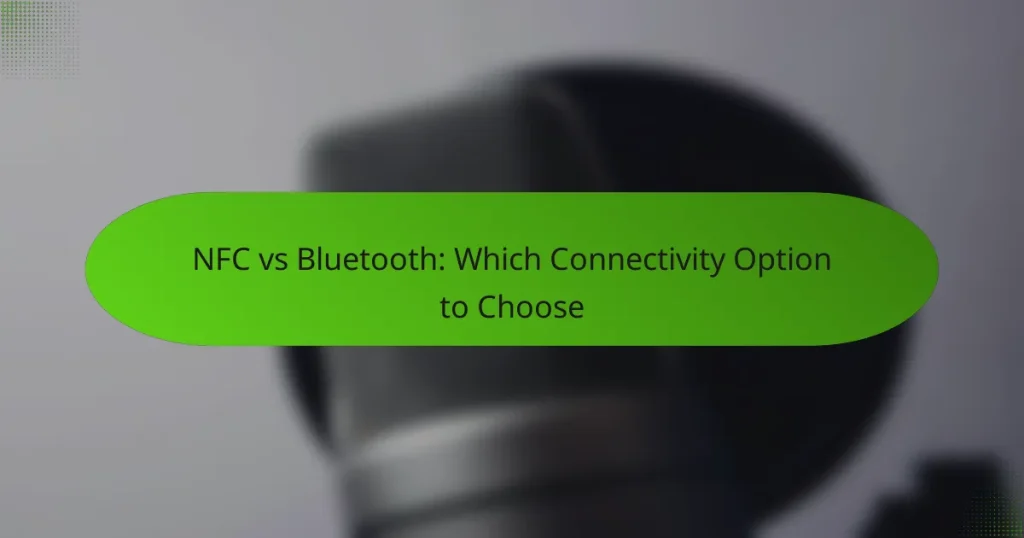Wireless earbuds have revolutionized the way we listen to music and take calls, primarily through Bluetooth connectivity. Pairing these devices with smartphones is typically a simple process, thanks to widespread Bluetooth support in modern devices. Factors such as Bluetooth version and earbud design can significantly influence connection stability and audio quality, making it essential to choose the right model for optimal performance.
Multi-Device Connectivity: Features for Professional Wireless Earbuds
Latency in Wireless Earbuds: Effects on Gaming and Movies
Stable Connectivity: Factors for Streaming Wireless Earbuds
Bluetooth Versions: Key Features and Compatibility
NFC vs Bluetooth: Which Connectivity Option to Choose
Range in Wireless Earbuds: Impact on User Experience
How to connect wireless earbuds to smartphones?
Connecting wireless earbuds to smartphones is a straightforward process that typically involves using Bluetooth technology. Most modern smartphones support Bluetooth, allowing for easy pairing with compatible earbuds.
Bluetooth pairing process
To pair your wireless earbuds, first ensure they are charged and in pairing mode. This usually involves holding down a button on the earbuds until a light indicator flashes, signaling they are ready to connect.
Next, open the Bluetooth settings on your smartphone. Look for the earbuds in the list of available devices and select them to initiate the connection. Once paired, you should hear a confirmation sound from the earbuds, indicating a successful connection.
Compatibility with iOS and Android
Most wireless earbuds are designed to work seamlessly with both iOS and Android devices. However, some features may vary between platforms, such as touch controls or voice assistant integration.
For optimal performance, check the manufacturer’s specifications to ensure compatibility with your specific smartphone model. Generally, earbuds that support Bluetooth 5.0 or higher will offer better connectivity and range.
Common troubleshooting steps
If you encounter issues connecting your wireless earbuds, first ensure that Bluetooth is enabled on your smartphone. If they still won’t connect, try resetting the earbuds by following the manufacturer’s instructions.
Additionally, check for software updates on both your smartphone and the earbuds. Sometimes, outdated firmware can cause connectivity problems. If all else fails, consult the user manual or the manufacturer’s support page for further assistance.
What are the best wireless earbuds for connectivity?
The best wireless earbuds for connectivity typically offer seamless pairing, stable connections, and low latency. Key options include the Apple AirPods Pro, Samsung Galaxy Buds 2, and Jabra Elite 75t, each excelling in different aspects of wireless performance.
Apple AirPods Pro
The Apple AirPods Pro are renowned for their effortless connectivity, especially within the Apple ecosystem. They utilize Apple’s H1 chip, which enables quick pairing with iPhones, iPads, and Macs, often connecting in under a second.
With features like Active Noise Cancellation and Transparency mode, they maintain a stable connection even in crowded environments. Users can expect a reliable range of about 30 feet (9 meters) in open spaces, making them suitable for everyday use.
Samsung Galaxy Buds 2
The Samsung Galaxy Buds 2 provide excellent connectivity, particularly for Samsung device users. They support Bluetooth 5.2, which enhances connection stability and reduces latency, making them ideal for watching videos or gaming.
These earbuds also feature a seamless switching capability between devices, allowing users to transition from a phone call to music without manual reconnection. Their effective range is similar to the AirPods Pro, around 30 feet (9 meters).
Jabra Elite 75t
The Jabra Elite 75t are designed for robust connectivity, featuring Bluetooth 5.0 for a strong and stable connection. They are compatible with both Android and iOS devices, making them versatile for various users.
These earbuds offer a customizable fit and a reliable range of approximately 33 feet (10 meters). Additionally, the Jabra Sound+ app allows users to manage connectivity settings and firmware updates, enhancing overall performance.
How does Bluetooth version affect wireless earbuds connectivity?
The Bluetooth version significantly impacts wireless earbuds connectivity by determining the speed, range, and stability of the connection. Newer versions, like Bluetooth 5.0, offer enhancements that improve performance and user experience compared to older versions.
Bluetooth 5.0 advantages
Bluetooth 5.0 provides several advantages over its predecessors, including increased range of up to 240 meters in open spaces and faster data transfer rates of up to 2 Mbps. This means users can enjoy higher quality audio and a more stable connection even when moving away from their devices.
Additionally, Bluetooth 5.0 supports multiple connections, allowing users to connect to multiple devices simultaneously. This feature is particularly useful for those who frequently switch between devices, such as a smartphone and a laptop.
Backward compatibility details
Bluetooth 5.0 is designed to be backward compatible with earlier versions, ensuring that newer earbuds can connect with older devices without issues. This means users do not need to upgrade all their devices to enjoy the benefits of the latest Bluetooth technology.
However, while backward compatibility is a key feature, the performance will be limited to the capabilities of the older Bluetooth version. For example, if connecting Bluetooth 5.0 earbuds to a device with Bluetooth 4.2, users may not experience the full range and speed benefits of the newer version.
What factors impact wireless earbuds connectivity range?
The connectivity range of wireless earbuds is influenced by several factors, including interference from other devices and physical barriers that can obstruct the signal. Understanding these elements can help users optimize their listening experience.
Interference from other devices
Wireless earbuds often operate on the 2.4 GHz frequency band, which is shared by many household devices such as Wi-Fi routers, microwaves, and Bluetooth gadgets. This overlap can lead to interference, causing a reduction in connectivity range and audio quality.
To minimize interference, keep your earbuds away from other electronic devices when in use. If possible, switch to a less congested frequency band for your Wi-Fi network, or use earbuds that support the 5 GHz band, which is less prone to interference.
Physical barriers affecting signal
Physical barriers like walls, furniture, and even your body can significantly impact the connectivity range of wireless earbuds. The more obstacles between the earbuds and the connected device, the weaker the signal becomes.
For optimal performance, maintain a clear line of sight between your earbuds and the source device. If you frequently experience connectivity issues, consider using your earbuds in open spaces or reducing the number of barriers in your environment.
How to improve wireless earbuds connectivity?
Improving wireless earbuds connectivity involves several practical steps, including resetting the earbuds and updating their firmware. These actions can help resolve common connectivity issues and enhance overall performance.
Resetting earbuds
Resetting your wireless earbuds can often resolve connectivity problems. This process typically involves holding down specific buttons on the earbuds for a few seconds until you see an indicator light change or hear a confirmation sound.
Each brand may have a slightly different reset procedure, so refer to the user manual for exact instructions. Generally, resetting clears any previous connections, allowing you to reconnect them fresh, which can eliminate glitches.
Updating firmware
Keeping your earbuds’ firmware up to date is crucial for maintaining optimal connectivity. Manufacturers frequently release updates that fix bugs and improve performance, so check for updates regularly through the associated app or website.
To update, connect your earbuds to your smartphone or computer, open the relevant app, and follow the prompts. This process usually takes just a few minutes and can significantly enhance the stability of the connection.
What are common connectivity issues with wireless earbuds?
Wireless earbuds often face connectivity issues that can disrupt audio quality and user experience. Common problems include audio lag during playback and connection dropouts, which can stem from various factors such as distance from the source device or interference from other electronics.
Audio lag during playback
Audio lag occurs when there is a noticeable delay between the audio signal and the visual action on the screen. This can be particularly frustrating when watching videos or playing games, as it disrupts synchronization. Factors contributing to audio lag include Bluetooth version, the quality of the earbuds, and the device they are connected to.
To minimize audio lag, ensure that both your earbuds and the source device support the latest Bluetooth standards, such as Bluetooth 5.0 or higher. Additionally, using devices that are close together can help reduce latency. If lag persists, consider adjusting audio settings or using low-latency codecs like aptX or AAC.
Connection dropouts
Connection dropouts happen when the audio signal between the earbuds and the source device is interrupted, leading to sudden silence or disconnection. This issue can arise due to physical obstructions, distance, or interference from other wireless devices. Environments with many electronic devices can exacerbate this problem.
To reduce connection dropouts, keep your source device within a reasonable range, typically within 10 meters (about 30 feet). Avoid barriers like walls or large furniture that can block the signal. If dropouts continue, try turning off other nearby Bluetooth devices or switching to a less crowded frequency band, if possible.






